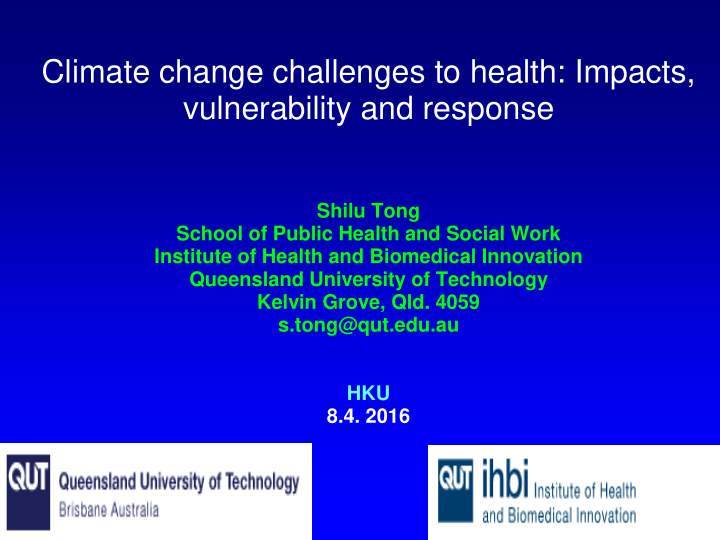



Climate change challenges to health: Impacts, vulnerability and response Shilu Tong School of Public Health and Social Work Institute of Health and Biomedical Innovation Queensland University of Technology Kelvin Grove, Qld. 4059 s.tong@qut.edu.au HKU 8.4. 2016 1
2 UNPD 2014
Projected future global population (Gerland et al. 2014; UN 2016) 3
4 www.who.int. Accessed 15/3/16
Life expectancy in Asian regions (UN 2016) 5
6 Smith et al, 2013
Environmental changes pose a significant threat to global health • Climate change • Marine pollution Climate change could • Urbanisation be the biggest global health threat of the • Ozone depletion 21st century. • Biodiversity loss Costello et al. Lancet 2009;373(9676):1693-733 • Soil degradation • Air pollution 7
8 McMichael 2012
9
10
11
Causes of change ‘It is extremely likely that human influence has been the dominant cause of the observed warming since the mid-20th century. ’ (IPCC 2013) IPCC AR5 WGI Fig SPM.6
Projected changes 13
‘ Global mean sea level will continue to rise during the 21st century. Under all RCP scenarios the rate of sea level rise will very likely exceed that observed during 1971 – 2010 due to increased ocean warming and increased loss of mass from glaciers and ice sheets. ’ (IPCC 2013)
Global impacts of climate change on crop productivity by 2050 (Wheeler & Braun 2013) 15
Climate change and the GBR • Expected adverse impacts from warming and higher CO 2 , leading to more acidic water Hoegh-Guldberg et al, Science (2007)
QUT Research Program – Ecosystem Change and Population Health 17
EHP 2013;121:415-9. IPCC AR5 Fig SPM.4
EHP 2013;121:415-9. IPCC AR5 Fig SPM.4
EHP 2013;121:415-9. IPCC AR5 Fig SPM.4
EHP 2013;121:415-9. IPCC AR5 Fig SPM.4
EHP 2013;121:415-9. IPCC AR5 Fig SPM.4
EHP 2013;121:415-9. IPCC AR5 Fig SPM.4
What does this study add? This is the 1 st study to look at both the short- and long-term harvesting effects in heat-related deaths. IPCC AR5 Fig SPM.4
EHP 2013;121:415-9. IPCC AR5 Fig SPM.4
EHP 2013;121:415-9. 26
EHP 2013;121:415-9. 27
EHP 2013;121:415-9. 28
EHP 2013;121:415-9. 29
What does this study add? This is the novel study to examine the relationship between climate conditions and H7N9 transmission. IPCC AR5 Fig SPM.4
Mortality risk attributable to high and low ambient temperature: a multi-country study Antonio Gasparrini, Yuming Guo, Masahiro Hashizume, Eric Lavigne, Antonella Zanobetti, Joel Schwartz, Aurelio Tobias, Shilu Tong, et al Lancet 2015;386:369-75. IPCC AR5 Fig SPM.4
32 Naish et al., 2013
33 Naish et al., 2013
34 Naish et al., 2013
What does this study add? This is a seminal study assessing low and high temperature-related mortality. IPCC AR5 Fig SPM.4
IPCC AR5 Fig SPM.4
EHP 2013;121:415-9. 37
EHP 2013;121:415-9. 38
EHP 2013;121:415-9. 39
IPCC AR5 Fig SPM.4
EHP 2013;121:415-9. 41
EHP 2013;121:415-9. 42
What does this study add? This is the 1 st study assessing annul net temperature-related mortality across different cities in Australia. IPCC AR5 Fig SPM.4
IPCC AR5 Fig SPM.4
IPCC AR5 Fig SPM.4
IPCC AR5 Fig SPM.4
IPCC AR5 Fig SPM.4
IPCC AR5 Fig SPM.4
IPCC AR5 Fig SPM.4
IPCC AR5 Fig SPM.4
What does this study add? This study reported a statistically significant decrease in the relative risk for heat-related mortality in 2006 compared with 1993 in the majority of countries included in the analysis. . IPCC AR5 Fig SPM.4
National Climate Change Adaptation Research Plan: Human Health (NCCARF, accessed 6.6.2015) The development of the Plan was led by the following writing team: Prof AJ McMichael (ANU) (Chair) Dr Haylee Weaver (ANU) Dr Helen Berry (ANU) Dr Paul Beggs (Macquarie) Prof Bart Currie (Menzies School of Health Research) Dr John Higgins (DCC) Prof Brian Kelly (Newcastle) Prof Jan McDonald (NCCARF) Dr Tharman Saverimuttu (DCC) Prof Shilu Tong (QUT) 52
53
Future challenges To engage in this increasingly-important topic area, we will need to generate skills and methods in: 1. Well-coordinated interdisciplinary research (including collaboration with some unfamiliar earth-system sciences). 2. Assessing causal relationships within a systems-change context: How do large-scale changes in ecosystems affect wellbeing, health and longevity of whole communities and populations? 3. Scenario-based risk assessments (forecasts) of climate change: Requires construction of models which are both sensible and realistic. 4. Economic research relevant to climate and health 5. Formulation and evaluation of community-based adaptive (coping) strategies. 6. Communications research 54
CONCLUSIONS • CC is, arguably, the biggest challenge to global heath in the 21th century. • Accruing evidence indicates an increased CC-related disease burden. • We must tackle this formidable, increasingly important public health challenge. • There is an urgent need to train more ECRs/students in this emerging field. • Funding is clearly needed to support the research agenda.
Acknowledgments 1. This program is funded by NHMRC, ARC, Queensland Departments of Environment and Resources, Community Safety, Queensland Health, Environmental Protection Agency & Queensland University of Technology; 2. Indebted to my collaborators, colleagues and students for their inputs. 56
57 Source: commons.wikimedia.org/wiki/File:Rotating_earth_(large).gif
Recommend
More recommend